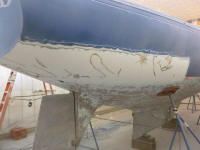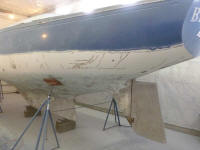
110 Cookson Lane | Whitefield, ME 04353 | 207-232-7600 | tim@lackeysailing.com
I continued work on the hull paint removal, starting with the starboard counter where I left off. Over the course of the day, I worked to remove the paint from the lower section of the hull, from the waterline to roughly halfway up, or as far as I could comfortably reach. Beneath the numerous layers of paint--both cheap paint and, down closer to the hull, higher quality, more durable linear polyurethane (LPU) paint systems--I found the hull to be in generally good condition, with numerous areas previously repaired to handle the usual gelcoat cracking.
Working my way forward along the port side, I reached amidships and began to uncover the edges of what appeared to be a large patch. Continuing along, I removed enough paint to find the forward end of the repair, then set up a temporary plank so I could sand the hull all the way to the gunwale and reveal the whole patch. The patch was entirely above the waterline, beginning roughly at the top of the old boottop and extending to the cove stripe beneath the gunwale. Lengthwise, it extended about six feet aft of the main chainplate knee.
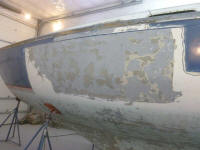
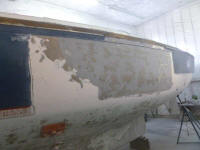
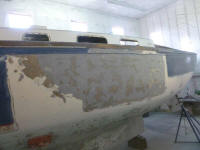
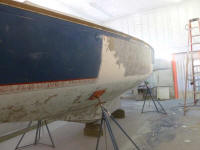
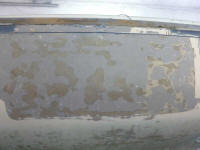
The existence of this area didnít come as a complete surprise. There were hints here and there that Iíd been seeing, enough to keep me from being shocked. For example, I had noted earlier, during interior disassembly, that the fiberglass work inside the port hull (in the main cabin) looked completely different than the starboard side and other exposed areas The port side didnít look like the factory glasswork, and was the only place that looked the way did. Instead of a homogeneous overlay of fiberglass, the port side's inner skin was made up of several narrower layers, and the quality of the work was at a lower level than that seen elsewhere.
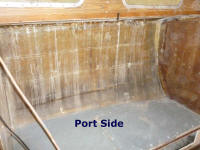
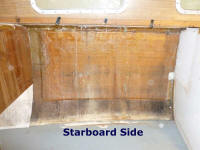
Outside the hull, there'd been no overt evidence of the repair work or what I was to find later. While the starting condition of the hull was pretty terrible in terms of cosmetic condition, the general shape appeared fair, and in and of itself had revealed nothing.
Photos from January 9, 2012
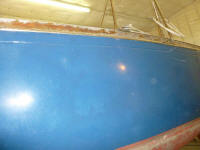
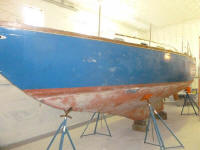
There were some cracks and what appeared to be loose or missing filler (since painted over) at the gunwale on this side, directly above where the repair turned out to be. This area had made me wonder what was going on directly beneath, but didn't point to the larger repair found.
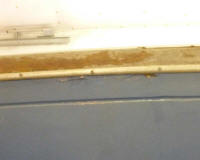
There was no way to determine exactly what had happened, or when the repair was made. Though clearly nothing recent, the repair appeared to have been made sometime after the boat was first painted, whenever that was; there were several layers of paint over the repair, but none of these layers were LPU or its primers. At the edges of the repair, there were some minor scratches in the high build/finish primer layers from this long-ago LPU treatment, which scratches had been filled and faired, further supporting the hypothesis of the repair's timing. Inside the boat, the glasswork on the port side was heavily stained with runoff from numerous leaks in the toerail and other fasteners (seen as white streaks on the fiberglass), which appeared to have been going on for some time.
Details notwithstanding, my initial assessment of the repair work suggested that it was structurally commensurate with the adjacent hull areas. I'd delve more into it later, but although surprising, I saw nothing in the repair to suggest a change of course for the project.
During the bottom stripping, I'd revealed evidence of repair work to the aft end of the keel, and, to a much lesser extent, the rudder. There was no way to know whether these repairs were at all related to the topsides repair.
Photos from January 23, 2012
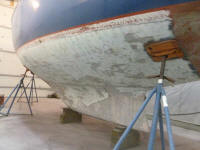
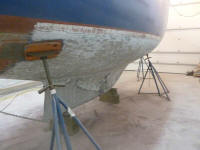
Old boats bring with them many years of history, and that history isn't always happy, but ultimately it's not surprising to find previous repairs in a boat this old.
Total Time on This Job Today: 7.25 hours
